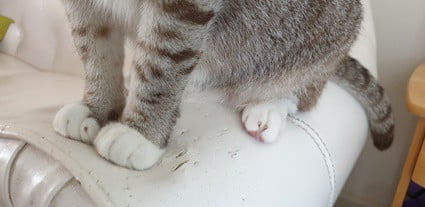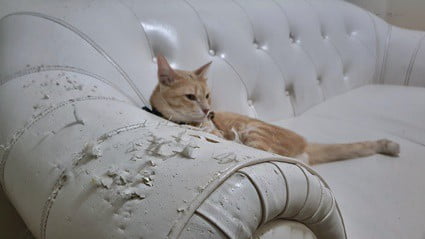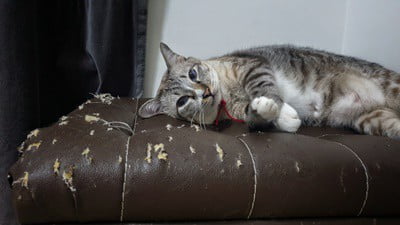Scratching is a natural behavior for cats. It helps to sharpen their claws, stretch out their muscles, and keep them entertained. Of course, this is disastrous in the home, especially if you own leather furniture. Cats don’t specifically target leather, but they don’t avoid it either. Even faux leather can fall victim to a cat, which leads to an expensive and unsightly problem.
To deter cats from scratching leather furniture, start by offering more scratching posts. You may need to buy different models, sizes, and textures to make them more appealing to the cat. After that, begin training the cat to never step on the leather furniture, using positive reinforcement. You can safeguard your leather with protective covers, such as scratch guards, drop cloths, or slip cloths. That can be topped off with anti-scratch sprays or your own smell-based deterrents.
Trimming your cat’s nails will help prevent it from scratching up the leather by accident. Even walking over your furniture could leave tiny pocket marks, so keep your cats away from the leather whenever you can. Leather can’t be completely repaired, but you can mask the damage. Using a colorant on small scratches will help disguise little pocket marks. You may eventually have to replace entire areas of the leather for straight scratches or have it reupholstered.
Do Cats Like Scratching Leather?
There is no definitive research to say if cats single out leather to scratch. Some people claim that the smooth texture is pleasing to their claws. Indeed, cats will intentionally sharpen their nails on the sides of leather couches and armchairs if given a chance.
Others say that cats will avoid leather because of that very texture. Your individual cat may target your fabric sofa long before it goes for the leather recliner. While cats tend to like some resistance in their scratching posts, any object will do if they’re bored or out of options. Even a cat that’s avoided leather in the past will resort to it if there are no available scratching posts.
Overall, there is no one breed of cat that avoids or targets leather. Likewise, there’s no way to tell if your cat will have a preference until you test it out with a piece of leather. It is natural for cats to sharpen their claws on different objects. It cannot be fully trained out of them, nor is it healthy for a cat to never scratch up items.
Why Do Cats Scratch Leather Furniture?
Cats scratch leather furniture as a way to maintain their claws. The gentle resistance that it provides can:
- Sharpen the claws
- Strengthen the joints that hold the nails within the cat’s paws
- Stretch out muscles in the cat’s paws
Because of that, scratching will even serve as a form of exercise and enrichment. In the wild, cats use trees, discarded bark, and other objects they find to sharpen their claws. Rather than letting them get dull and stiff, cats regularly use them so that they’re primed and ready for hunting when needed.
In your house, cats don’t have these natural materials. Instead, they use anything upright, stiff, and with a texture that gives them some resistance. In some cases, this will include your bedding, curtains, carpets, and of course, your leather furniture.
The Journal of Feline Medicine and Surgery surveyed cat owners about their cats’ inappropriate scratching. According to their findings, 81.5% of cats scratched chairs or other furniture, and 64.7% scratched carpet. Therefore, an overwhelming majority of cats tend to scratch not only leather but all types of furniture. This is likely because it mirrors trees they would find in the wild.
Cats may also scratch up your leather by accident. Although felines can retract their claws, these nails often emerge when they are jumping or climbing. This gives them extra stability and makes the creatures nimble, but it spells bad news for your furnishings. A cat springing from one sofa to the next may accidentally leave claw marks behind. Even if they’re negligible at first, after a few weeks, there will be no hiding the presence of a cat all over your leather.
Do Cats Scratch Faux Leather?
Some owners believe that cats only target real leather. Supposedly, the texture and smell feel more natural. This encourages cats to scratch up authentic hide like they might find on carcasses in the wild. Unfortunately, research is uncertain if cats are drawn to leather, so real or fake doesn’t make a difference.
Your cat may target your faux leather as readily as proper leather. Your cat may also dislike the smell, texture, and feeling, therefore giving it a wide berth. Sadly, you can’t invest in faux leather as a loophole for dealing with a cat in the house. It would be a crapshoot in any case.
In fact, real leather and faux leather are very similar in texture. Even if your cat did purposefully target leather, this isn’t guaranteed to scare it off.
There are advantages to faux leather over real leather, though. Fake leather is much cheaper. Perhaps you absolutely love the aesthetic in your home décor but don’t want to throw several thousand dollars away just by sharing it with a cat. In this case, faux can lower your replacement costs.
Likewise, faux leather has many of the same advantages as real leather. It’s easy to clean and won’t collect a lot of fur. That can make tidying up a pet-friendly home much simpler, even if the furniture gets clawed up anyhow.
How to Protect Your Furniture from Cats
Since leather furniture can be very expensive, it is important to protect it from cats. Of course, there is no way to entirely cat-proof your sofas and chairs. Cats may scratch up leather even by accident, just by walking on it. A certain amount of damage is guaranteed.
Even still, there are safeguards you can put in place. This can reduce the amount of damage and discourage cats from totaling your leather on purpose. It’s a good middle-ground when you don’t want to replace all the furniture or watch it get destroyed.
Trim Your Cat’s Nails
If your cat scratches the leather seat cushions just by walking on them, then the problem may be that its nails are too sharp. In that event, trimming your cat’s nails will help reduce the amount of damage it can do by accident. The tips will be dulled, so even if they emerge when the cat jumps, they won’t pierce the material as easily.
As a bonus, the cat will be less able to scratch other objects or even you (unless it’s trying). To trim your cat’s nails, use:
- A pair of nail clippers designed especially for cats (which is helpful if your cat squirms)
- Normal nail clippers (if you have a good hold on your cat)
Cats will make a fuss when you’re trimming their nails. The best time to do it is while they are sleeping or just after a nap. They will be far more docile at these times. Here’s how:
- Gently press on your cat’s paw until the individual nail pops out.
- Only cut the sharp point of the claw, and don’t go too deep.
- To be safe, always cut the very tip – you need the claw dulled, after all.
- Avoid the quick at all costs. The quick is a darker section near the base of the nail.
- Trimming your cat’s nails should never hurt, so if the cat is crying out when you press down with the clippers, you’re cutting too high up the nail.
- Keep the cat very still as you make the trim to avoid missing the mark.
It may seem like a hassle to trim your cat’s nails. However, it will dramatically reduce the level of wear and tear on your leather furniture. You can update the trim whenever you notice they are sharp again. This is usually every 2 weeks or so.

Don’t Allow Your Cat on the Furniture
Obviously, if the cat is unable to touch the leather, it cannot damage it. This is easier said than done, of course. Cats tend to go wherever they please, and it isn’t easy to maintain a close eye on your furniture at all times.
The good news is, you can train a cat to stay off certain furniture with a reasonable success rate. It won’t be 100%, but it can give your leather a better lifespan. To train your cat not to jump on the furniture:
- Provide an alternative lounging spot for your cat that’s near the furniture.
- When your cat jumps onto the leather, pick it up or shoo it off gently.
- Try not to frighten the cat, as it may dig in its nails as a reflex.
- Once the cat is off the leather, place it in the designated spot.
- Reward your cat with praise, chin scratches, and a treat if possible.
- When you see your cat using the designated spot without your help, reward and praise it.
Over time, your cat will realize it can obey you, receive good things, and still get a prime lounging spot. It doesn’t need to sacrifice much. Staying off your leather recliner is a small price to pay.
Of course, your cat may revert if you’re not watching. It may also need its training updated every few months. However, it does slash the amount of time the cat spends on your furniture by a wide margin.
Just be sure to avoid negative reinforcement whenever you can, such as yelling, hitting, or scaring the cat. At the very least, your cat is more likely to scratch up the leather by accident as it retreats from you.
Provide More Scratching Posts
Cats will choose quality over quantity. A scratching post that’s the right size, texture, and even smell will be a far better choice than your leather sofa. If your cat keeps intentionally scratching the sides or back of your furniture, then it may feel it’s out of options.
Even if you have scratching posts already, they may be worn-down or placed in the wrong spots. Maybe your cat doesn’t want to traverse to the back bedroom to stretch its claws.
Likewise, the cat may not have enough scratching posts and is using your leather as a substitute. According to The Journal of Feline Medicine and Surgery, cats don’t scratch inappropriate surfaces as much when more scratching posts are added into the home.
In the above study, researchers determined that most cats preferred rope-based scratching posts. However, geriatric cats preferred carpet-based. With that in mind, your cat may need more specific posts to be happy. Try buying a few different kinds and placing them throughout your house. When the cat is spoiled for choice, your leather should become a distant, easily ignored temptation.
If your cat doesn’t give up on your leather furniture after all that, you may need to train it to use scratching posts. Some cats are slow learners, while others won’t recognize them as a toy. Try redirecting your cat to the new scratching posts every time it touches your leather. If it complies or starts using the posts as a part of its routine, praise and reward it.
Spray to Stop Cats from Scratching Furniture
Cats have powerful noses and are deterred by certain smells. If you coat your leather with these aromas, the cat will think twice about approaching. You can buy “cat scratch sprays” or “anti-scratch sprays” online or in pet stores.
You can also try making your own spray. Start by mixing a solution of water with vinegar, essential citrus oils, garlic, or peppermint. These scents are strong and offensive to cats but won’t damage leather. A light misting over your furniture every few days should drive the kitty off. Over time, even if you no longer spray the odor, the cat should know to steer clear.
This isn’t a perfect solution. Some cats don’t mind the odor, and others will overcome it when bored enough. That makes it best when paired with the other methods in this list.
Furniture Protection from Cats
If you don’t mind the look, you can try covering up your leather furniture with a scratch guard. These can be used independently or (if you’re extra careful) paired with a drop cloth or slip cloth.
Leather Scratch Guard
Scratch guards are composed of a sheet of thin plastic. They can be stuck or mounted to the sides and corners of your leather furniture. Depending on the brand, they will strictly adhere to the furniture with thin tape or be mounted with little pegs. No matter the case, they create a barrier that’s more difficult for your cat to pierce with its nails.
Since these guards only attach to the sides and corners of your leather, they cannot protect the cushions. However, most cats target the corners and sides, as they’re the most abrasive parts of a sofa or chair. That makes them excellent for sharpening claws, but all the joy is taken out of it with the thin plastic.
You can buy these sheets or make your own by putting heavy-duty tape onto your furniture. They may need replacing if your cat is persistent, or they may last for years. No matter the case, one downside is that they are unsightly to some people, even if they’re see-through.
Drop Cloth or Slip Cloth
A drop cloth or slip cloth covers the full length of your furniture. This not only protects it from dust but also scratching claws. If you’re concerned about aesthetics, this is the least invasive option. With a tight enough fit, you may hardly notice the cover (and note the sound as you sit or move).
Unfortunately, these won’t protect the sides of your furniture as much. The thinner material is less resistant to a dedicated cat, and the corners will still be a prime target that your cat puts effort into. However, if you pair it with training and strong-smelling deterrents, it can keep your furniture alive until the cat learns better. It also works great against accidental scratches if your cat walks across it.
Do Cat Claws Ruin Leather Furniture?
Whether or not cats prefer leather, we know for certain that cats can inflict irreparable damage on leather. That has to do with the porous nature of the material.
Unlike fabric fibers, leather has very little tension and can’t “squish together” to seal or mask holes. Any blemishes, scratches, or tears will remain prominent and obvious. For owners, this usually leaves a binary option: choose to own a cat or choose to own leather furniture.
Leather also has different coloring in its layers. For example, a tiny scratch on black leather could reveal the paler shades beneath, making the damage obvious. If the cat manages to get down into the stuffing, that color difference will be hard to ignore. This makes even tiny blemishes a huge problem.
While it’s possible to “repair” leather, this usually involves replacing large chunks or coloring the damaged areas. This can make the scratches harder to detect with the naked eye, but leather can’t be fully repaired. The leather aesthetic is also very unforgiving when it’s damaged.
Although a fabric sofa that’s been scratched can just look aged by a few years, leather can go from “brand new” to “trashed” in an afternoon with a dedicated cat. Likewise, the scratches may expand as you sit on or move the furniture since leather is very pliable. It doesn’t take much pressure for a thin crack to expand across the entire arm or cushion. With that said, some scratches are more damaging than others:

Straight Line Scratches
These are found most commonly on the sides of leather furniture. Cats that are sharpening their claws will bury the nails deep within the material and pull down. This creates long, sharp lines that often overlap, especially if the cat has been busy for a while.
These types are the hardest to repair. At the very least, you will need to replace large chunks of the leather. The scratches are very likely to expand and “fray” over time.
Stubbed Holes
These are most commonly found on seat cushions or the back of the furniture. Cats may extend their claws gently as they walk to remain stable. This lets the nails create little pocket-marks as they walk. If you happen to scare the cat, it may create larger holes or “tear-drop” holes. This happens when the cat extends its claw further and is pulled out with force as the cat runs.
These scratches are usually accidental. While “repair” is a strong word to use, these can be more easily repaired. Applying a colorant will help mask the damage. As long as it’s not exacerbated, your leather furniture may appear mostly undamaged.
How to Repair Leather Damaged by Cats
As mentioned, leather can’t be “repaired” as you might expect. The holes or straight-line scratches can’t be sewed back together as you might do with fabric. Instead, you’ll be trying to isolate the damage and color it until it’s difficult to see visually. Your main options will include:
- Using a re-coloring balm on the affected areas
- Using a repair kit to replace chunks of the leather with new pieces
- Hiring a professional to reupholster the furniture for you
Cats can’t be entirely stopped from scratching leather furniture. However, you can discourage your cat from ruining your favorite chairs and sofas with the above tips. If you train the cat while it’s young and use protectors over the furniture, you may even buy the décor several years before it shows serious wear.

